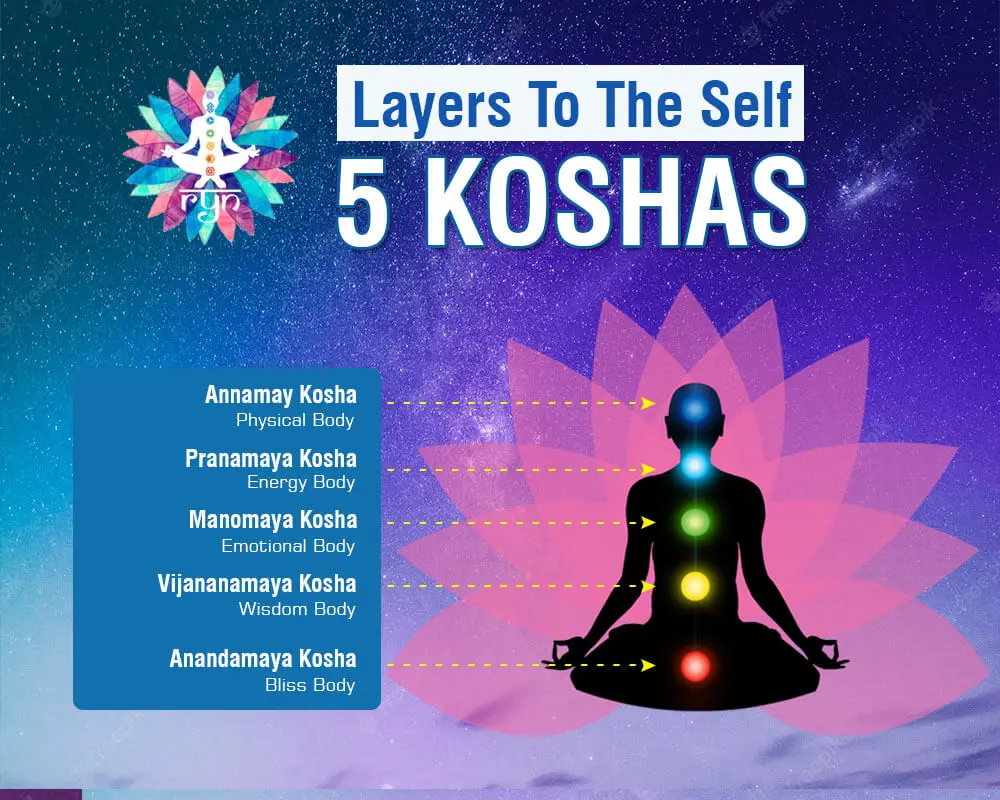
Get A Free Quote

The 2 word Pancha Kosha is originally taken from the Sanskrit words, where Pancha means five while Kosha means covering. Therefore the Pancha Kosha covers the five essential elements of awareness from outside to inside the body.
The concept has its origins in the Taittiriya Upanishad, a Sanskrit text with its roots in the Yajurveda that can be traced back to the Vedic era. The ancient science of Yoga says that our self or being has five layers and each of these five layers form a “kosha,” or a sheath. These “koshas” are in the form of layers that extend from the outermost layer of the physical body to the innermost layer of the spirit which is the core. Let’s look into the five koshas in more details.
The body’s outermost layer that’s related to food is the “annamaya kosha.” We can see it and touch it. The five elements, namely, earth, water, fire, air, and space form this outermost “kosha” or layer. It’s the food we digest that forms the “annamaya kosha” which is why it’s referred to as the food sheath. Once we die, this layer goes back to its original form of food or other animals and plants.
This is the most basic form of all the sheaths or layers and the pleasures the human body gains at this layer last only for a short while. Yoga asanas help us go beyond the constraints imposed by this sheath.
The pranamaya kosha regarded as the vital sheath can’t be seen by ordinary mortals as it’s much finer than the more basic food sheath. It’s the pranamaya kosha and the more basic layer, the annamaya kosha through which human beings express themselves. The pranamaya kosha is therefore the breath and the life that comes with breathing.
Our being alive and dead are separated by the pranamaya kosha. While prana brings us life, its absence is an indication of life ending, or death. Since the pranamaya kosha is closely tied with life and death, its link with the annamaya kosha is very deep as well. The annamaya kosha falls apart as soon as prana departs from the body, or in other words, we die.
The five pranas—prana, udana, vyana, samana, and apana form this layer of pranmaya kosha. These also create the five organs through which we perform actions. These are the “karmindriyas” or the mouth, the hands, the feet, the rectum, and the genitals. We nurture the pranamaya kosha by providing it with nutritious food and the other essentials of life like sunlight and breath. It’s performing pranayama that helps yogis move out of the confines of this layer or kosha.
Manomaya kosha or the mental sheath forms the next layer. Apart from the mind, it’s the subconscious, and the five organs that help gain knowledge which form this kosha or sheath. These five organs are referred to as the jnana indriyas are the organs that actually help us feel the sensations and these essential organs are —the eyes, skin, nose, tongue, and ears. Our minds receive information through these five esense organs and it’s these very organs that are behind us feeling our desires.
It’s our thoughts, emotions, imaginations, feelings, memories that are embedded in our subconscious mind that form the manomaya kosha. If we fail to control our minds, we may take destructive action that harms our wellbeing. The technique we need to adopt to make ourselves strong is to follow the yamas, niyamas, and practicing selfless service or karma yoga.
This is the layer of the intellect, even more refined than the mental sheath. We also refer to it as the knowledge sheath or the sheath of wisdom. It is this layer of wisdom that gives us good sense and separates us humans from animals. Both man and animal are bestowed with feelings, emotions, memories, and thoughts, but only man can tell the right from the wrong.
The vijnanamaya kosha includes our egos as well that makes us conscious of our identities and makes us self centered. We can make this layer stronger through the pursuit of knowledge or jnana yoga. We have to understand our own selves through meditation and by studying scriptures and spiritual texts.
This is the innermost layer, the final kosha or sheath, also the most refined of all the layers. This layer bears the vasanas or the desires our personalities nurture. It’s a manifestation of what our souls have experienced through the many rebirths.
It’s through this layer that we connect with the divine power. We remain trapped in the rebirth cycle until we successfully transcend this layer. Once we have attained that, we achieve self-realization, or the state of Samadhi. What lies beyond these five layers is our atma or the self. While the anandamaya kosha does bring you close to the soul or the atma, the atma still remains outside the five layers or koshas.
Knowledge of the pancha kosha helps in self realization. You make your way through the basic layers and as you reach the outer layers, you refine yourself and discover your real self.